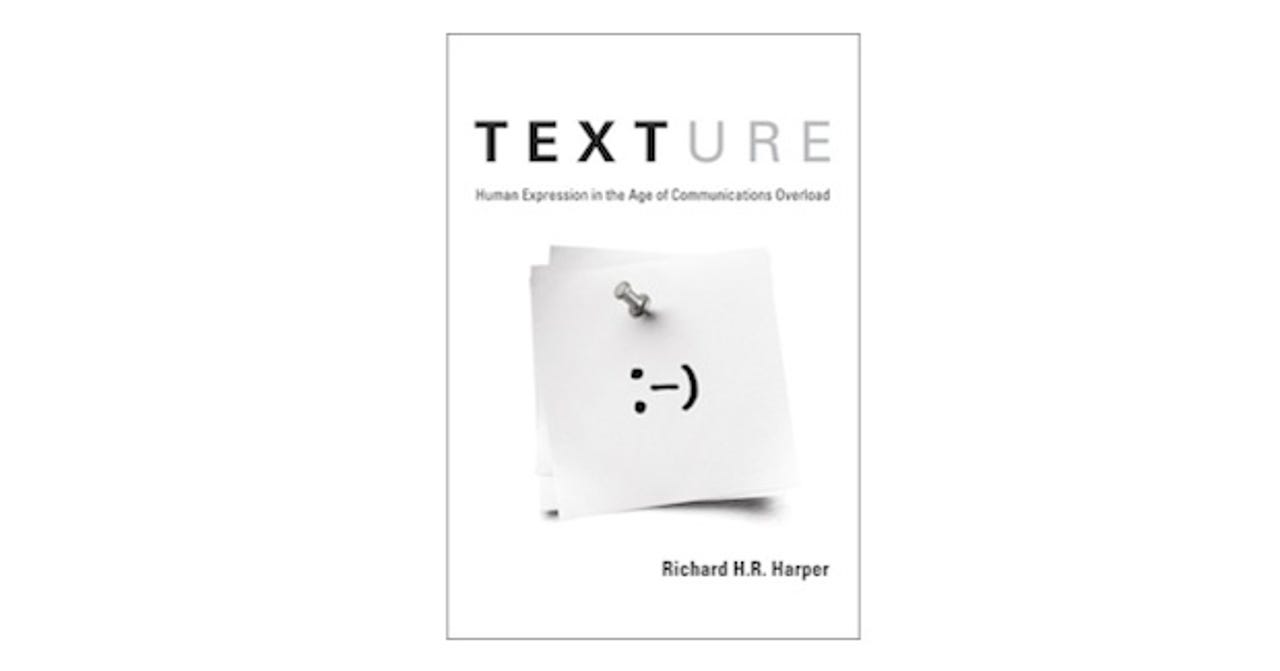Book review: Texture

If we're drowning in email and past the point of keeping up with everyone we've reconnected with on Facebook, why are we flocking to Twitter? If we can't settle down to work because instant messages keep popping up on top of the document, why are we adding to the load by uploading videos to YouTube and answering questions on Quora?
Inventors of new technologies like Google Wave think that they will — by dint of being faster, richer or just novel — replace slower, more basic tools. However, we rarely drop a tool we've begun using: instead we try to pick the right communication for each message. So says Richard Harper, from Microsoft Research, in Cambridge in Texture, a dense book that's sometimes dry, sometimes revealing and always insightful. We are what we say, suggests Harper — but how we say it matters a lot to us. We like to have a rich and nuanced vocabulary, and although novelty is appealing, in the end we choose to use all these different ways of communicating because we get something different out of each one.

Although this overload is a new problem, it's part of a gradual change in how we communicate. Harper looks at how letters evolved from being public documents crafted to display the insight, vision or knowledge of the writer, published to make money, climb the social ladder or simply as art, to become personal messages for creating connections. He compares this to blogs and social networks, and finds useful and interesting truths to convey about blogs and social networks along the way. Harper also takes a novel look at the Turing test and how it ignores most of the important issues in communicating.
Most interesting are his descriptions of technologies including: early telepresence systems at Xerox EuroPARC (where they appear to have reinvented IRC); a Microsoft Research system called i2i for editing paper documents on computer by gesturing with your hands; another MSR project for filtering messages by gathering vast amounts of information about what you do; the Whereabouts clock (based on the clock in the Harry Potter books) and the 'glancephone' — which was designed to let you see if a friend was busy and turned into a way of enticing friends to look at each other doing something they thought was worth seeing. Harper's accounts of how often technology inventors either don't use it themselves or are surprised by how differently people use it in the real world are amusing — and a little worrying, because they suggest that academic research can be badly out of touch.
Harper spends a lot of the book pointing out the tensions in how we think about communicating and expressing ourselves. Having decided that communicating more was good, we created a world with so much communication that we're now unhappy with it. Huge numbers of messages are a burden, but they're also a reminder of all the people who want to stay in touch with us. We worry about 'stranger danger', but actually use social networks mostly to stay in touch with people we already know — or to exclude people who want to stay in touch with us.
In the end, you discover, you might be complaining not about the emails, phone calls, tweets, updates and messages you have to deal with, but about the work, family and friends to which they connect you. Texture is an excellent reminder of the richness of communication and the social fabric we weave from it.
Along the way, Texture is a tutorial in philosophy, communication theory, sociology, education, cybernetics and the way projects in research labs work. It's not a how-to or self-help book, although if you want to cut down on the ways you communicate or pick the right tool for a specific message, the thoughtful review of how and why we've communicated in the past is thought-provoking. Harper's descriptions can veer into Private Eye's Pseud's Corner territory from time to time ("A tweet is a way of catching the breath of the blogosphere even as it exhales"), the academic style summarises the arguments rather too often for a mainstream audience and there aren't many books that can put blogs and Baudrillard in the same paragraph. But he also has a nice way of bringing airy philosophical discussions down to earth and giving some perspective to scaremongering about the threats of new technology.
Texture: Human Expression in the Age of Communications Overload Richard H.R. Harper MIT Press 384 pages £22.95 ISBN: 978-0-262-08374-4
Mary Branscombe